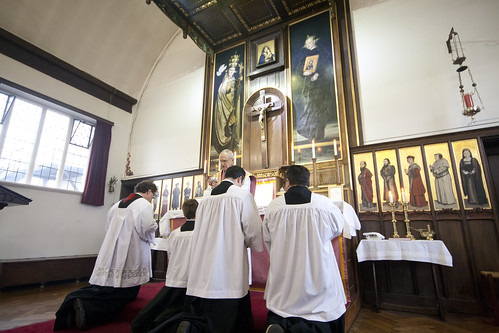 |
| The small church of SS Gregory & Augustine in Oxford, with the recently installed paintings the Catholic artist James Gillick. |
He addresses a series of arguments against the importance of beauty in the liturgy, church buildings and so on. The first of these is the accusation of 'aestheticism': that those who value beauty are guilty of this error. So, what is aestheticism? Hildebrand defines it: it is an appreciation of beauty detached from the meaning of the beautiful object: in the case of the liturgy, it is an appreciation of the architecture, vestments, music, poetry and so forth without reference to the theological and moral content which these things are seeking to convey to viewer and auditor. There is such a thing as 'aestheticism', it is bad, but those attached to the Traditional Mass can make it clear that they are not guilty of it. It is, after all, perfectly obvious that that as a movement we care very deeply about the content, the meaning, of the beautiful things found in the liturgy. We aren't just as happy listening to, say, a melodious Arian hymn sung with skill, as Palestrina. The theology of an artefact is, for us, inseparable from our appreciation of its aesthetic qualities.
Here is Dietrich von Hildebrand.
P162.
Many priests believe that replacing the sacred atmosphere (that reigns, for example, in the marvellous churches of the Middle Ages or the Baroque epoch, and in which the Latin Mass was celebrated) with a profane, functionalist, neutral, and even humdrum atmosphere will enable the Church to encounter the simple man in charity, But this is a fundamental error. It will not fulfil his deepest longing; it will merely offer him stones fro bread. Instead of combating the irreverence so widespread today, these priests are actually helping to propagate this irreverence. They do not understand that esoteric pontificalism [to be discussed later: a form of clericalism] is really a form of secularization and that its true antithesis is holy unction, which all the saints possessed--the spirit of reverence, the fusion of humility with a demeanour appropriate to the sacred office.
Pp229ff
Aestheticism is a perversion of the approach to beauty. The aesthete enjoys beautiful things as one enjoys good wine. He does not approach them with reverence and with an understanding of the intrinsic value calling for an adequate response, but as sources of subjective satisfaction merely. Even if he has a refined taste is a remarkable connoisseur, the aesthete's approach cannot possibly do justice to the nature of beauty.
Above all he is indifferent to all the other values that may inhere in the object. Whatever the theme of a situation may be, he looks at it solely from the point of view of his aesthetic enjoyment or pleasure. His fault does not lie in overrating the value of beauty, but in ignoring the other fundamental values--above all, moral values.
...
If someone were to refuse to go to Mass because the church was ugly or the music mediocre, he would be guilty of asetheticism, for he would have substituted the asesthetic point of view for the religious one. But it is the antithesis of aestheticism to appreciate the great function of beauty in religion, to understand both the legitimate role it should play in the cult and the desire of religious men to invest the greatest beauty in all things pertaining to the worship of God. This correct appreciation of beauty is rather an organic outgrowth of reverence, of love of Christ, of the very act of adoration.
The next argument that Hildebrand considers is that a concern for beauty in the liturgy is opposed to the evangelical poverty to which the Church is called.
Support the work of the LMS by becoming an 'Anniversary Supporter'.
No comments:
Post a Comment